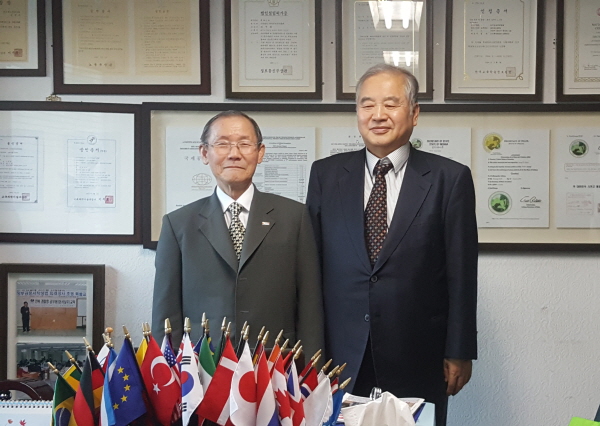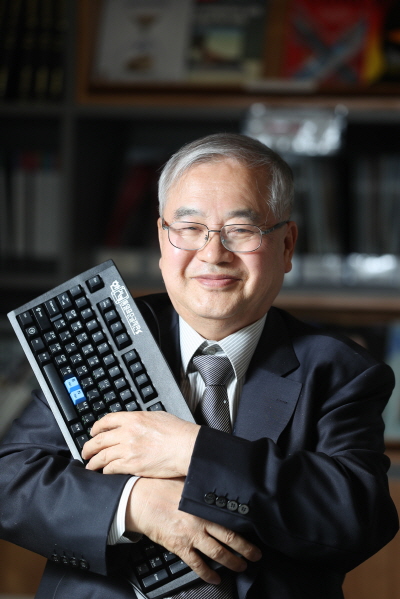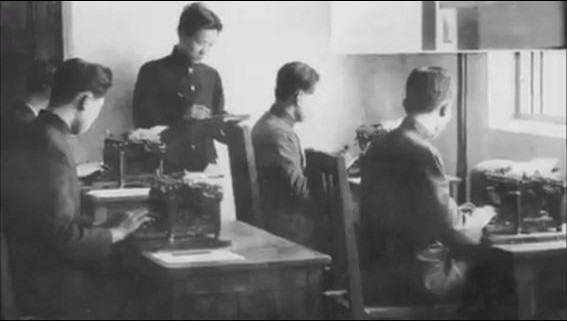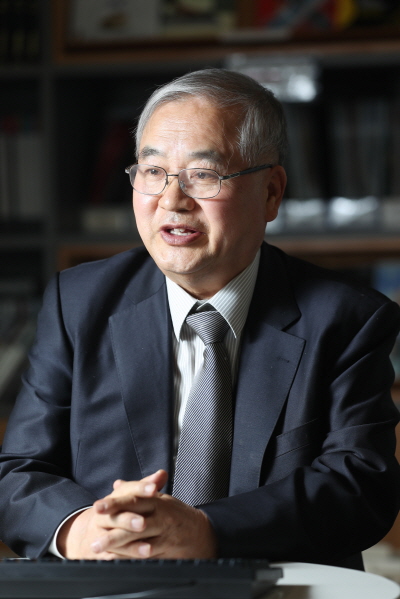Positioned to achieve “real national unification”
“There is only one person in the Republic of Korea who is able to achieve real national reunification of the Korean peninsula.” A friend of mine told me so recently. It certainly was like a bolt from the blue.
“Who could be that person?” I wanted to know.
North Korea's Kim Jong-un shows the cold shoulder to the Moon Jae-in regime which has pursued an appeasement policy. The North Korean regime also turned down all appeasement gestures so far made by President Donald Trump of the United States.
The person in point is Chairman Cho, Sok-hwan of the Korea Association of Information Management (KAIM), who has pushed for the standardization of Hangeul keyboards for decades. The Korea Post recently interviewed Chairman Cho to hear about his passion on the Hangeul keyboard project which may also contribute to the realization of the divided Koreas. Excerpts from the interview with Chairman Cho follow:

Answer: Our keyboard standardization undertaking dates back to half a century ago. Tens of millions of computer users worldwide have been able to gain access to the Korean standard keyboard system (KS C 5715) since it was designated as a global standard by the South Korean government in 1982. Despite the government-level exchanges between South Korea and North Korea had remained frozen, Cho, Sok-hwan, chairman of the Korea Association of Information Management, signed an agreement on academic exchanges with North Korea with regard to a unified keyboard project in preparation of national unification. South and North Korea jointly developed the “Hangyeore Unified Keyboard Layout of Digital Telecommunication Devices.” We registered pertinent trademark & technology patents in the South.

A: After becoming a member of KATUSA (the Republic of Korea Army Augmented to the Eighth United States Army) in the 1960s, I first accessed the IBM computer and the digital keyboard. Even after leaving the army, I remained interested in the computer and went to the United States for advanced study. I worked hard to install the Hangeul alphabet on the computer keyboard. Eventually, l became a national computer keyboard specialist, while working hard to unify the computer keyboard layouts of South and North Korea.

Of note, Kong Byung-woo (1906-1995), who developed the “triple-set” typewriter, had a great impact on me. He once invited me to his office and called for me to spearhead the development of triple-set typewriter. Unlike the Hangeul typewriter used by Koreans today, which features a “double-set” keyboard layout, Kong’s typewriter exhibited a “triple-set” layout containing the end consonants in addition to the first consonants and vowels. He earnestly asked for me to commit to the job of developing a unified keyboard standard amid high tensions in the Korean Peninsula. In 1969, the Korean government adopted a double-set keyboard layout after many twists and turns. Since then, the double-style computer keyboard has become a global norm. The National Computer Keyboard Commission was created around that time.

There were several reasons for the adoption of the double-set keyboard layout. In the 1980s, one big problem related to poor printing ability of the triple-set keyboard system. At that time, the printing quality of the triple-set keyboard was very poor. However, now that the printer's performance has significantly improved, printing on triple-set keyboard layout poses few problems. But it will be impossible for large numbers of people to shift to the double-set keyboard system all of sudden. Like in the United States, both double-set and triple-set keyboards can be put to use. Today, the QWERTY keyboard is widely accessed in the United States, but the Dvorak simplified keyboard is also recognized as a standard keyboard.

A: In the early 2000s, industrial standardization of the two Koreas was a key issue. The industrial standardization of both Koreas was hard to achieve due to the prolonged division of the peninsula. Thanks to our concerted efforts to reach an agreement with North Korea, however, we came up with the finished product which obtained technology patents in South Korea. It was named “Unified Hangyeore Keyboard.” While we were able to register the technology patent at an earlier time, the patent registration of the word, “Hangyeore” took more time. Eventually, we won a crucial lawsuit, which enabled us to use the word legally.
Although South Korea gains greater access to the operating system (OS) of Microsoft (MS), North Korea adopts Linux like Europe. This is the reason that the unified keyboard was developed by installing both MS and Linux. In response to the market trend, the Google Play Store installed the “Hangyeore Unified Standard Keyboard” app a year ago.

A: After acquiring a Ph.D. in business administration from Yonsei University, I have devoted myself to doing research on the keyboards. I have spent more than 50 years in R&D on keyboards. I became keenly interested in the unified keyboard one year after I was named chairman of Special Computer Keyboard Committee of Korean Agency for Technology Standard in 2004. While traveling to North Korea for academic exchanges, I felt the necessity to create a unified keyboard in the event of national unification. Our Northern partner was “National Reconciliation Council” which was responsible for academic exchanges with South Korea. However, we accessed North Korea via the language information management society of Chinese-Koreans in China since it was difficult to travel to the North very often. It is hoped that the unified keyboard will become a stepping stone of national unification, while it may take time for the keyboard to be accessible in daily life.

Eventually, both Kim Dong-hoon and Kong Byung-woo threw in the towel. I had to manage all related issues. I have started collecting Korean typewriters since. I became a high school teacher. I was urged to lead the national computer keyboard special committee by the Korean Agency for Technology and Standards. Soon, I embarked on a 160-million-won research project. As for the mobile Hangeul keyboard, C model developed by Samsung Electronics and N model created by LG Electronics were considered de facto standards in view of the market principles.

The history of digital keypad standardization lasting half a century is never short. One obvious fact is that while an effective and scientific layout method is important, it may be difficult to ignore market principles (de facto standards.) As a result, the adoption of multiple standards seemed reasonable.
The announcement that developer Cho Kwan-hyeon would give up all patent rights related to the Cheonjiin keyboard model, which has become a de facto standard, was a watershed in the development of national standards. On this occasion, I sincerely hoped that this model would be in great demand as a global standard for digital keyboard.
A: It was reported in October last year that the Chinese-Korean information society in China will kick off a standardized keyboard layout project. China’s “Hangeul Project,” which calls for developing the method of Hangeul input on mobile devices including smartphones, has fueled anti-Chinese sentiments in Korea.

The history of Hangeul standardization dates back to half a century ago. Today tens of millions of Hangeul computer users access the computer information processing keyboard. This keyboard had already been globally standardized. The sudden reports on China’s “Hangeul Project” have thrown Koreans and the political circles into confusion.

